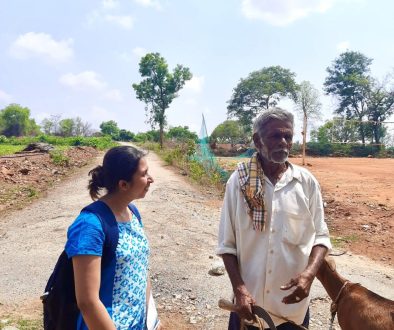Introducing Mairi Franklin: developing new tools for sustainable agriculture
In this blog post, we met with new NISD member and John Innes Centre PhD researcher Mairi Franklin to ask what brought her to Norwich and what she will be researching.
Can you tell us a little about your background?
I studied biology at Oxford University but have always been motivated by sustainability, and this has lately come to focus on agriculture. At the crossover between ecology and agriculture, I discovered my interest in plant-microbe interactions in the soil, which led me to do my Master’s on a project to engineer nitrogen-fixing rhizobia for barley. I found synthetic biology and biotech tool development really exciting. After my Master’s, I moved to the John Innes Centre and came across Dr Peter Emmrich’s work. Now I find I’m working on plant genetics and CRISPR, which feels quite different to the areas of biology I started from!
What are your research interests now?
I’ve realised that I love research on practical tools that people can use for agriculture. This started with my Master’s, and now my new work with gene editing could offer exciting improvements for others to apply. There’s something satisfying about the process of making a tool and knowing that it could be useful for other people’s work. It’s an ongoing process of troubleshooting, but I find it motivating how goal-oriented it is.
That goal at the moment is about improving how we can gene edit legumes and it’s exciting to use cutting-edge technology on this challenge and learning as I go. It’s also great that people seem to be interested in what we are working on and the speed enhancements we are aiming for. Actually a surprising discovery I’ve had is how inefficient and slow some of the steps currently are in legume improvement. That’s really the barrier we’re looking to overcome.
Can you tell us a bit more about the PhD?
The goal is to develop a system of virus-induced gene editing for grasspea and pea. In gene editing, we have two components, a pair of endonuclease ‘scissors’ (the most widely used gene being Cas9) and a guide RNA that determines where to make the DNA cut.
In virus-induced editing, a viral vector is used to deliver the guide RNA. However a prerequisite of this is having a transformed plant that produces the Cas9 protein across the entire plant. Making a plant line like this is hard in most legume crops so a big question is whether we could use a virus to deliver both the guide RNA and the Cas endonuclease. This has been tried before but has generally failed because the Cas9 endonuclease is too big for viral packaging. But now we have new miniature Cas endonucleases, so we’re trialling to see if this approach could work. If we do this, we’ll have a way to get CRISPR-Cas editing reagents to be expressed transiently in the plant, in an non-invasive way.
Why is this kind of research important?
Legumes have lots of benefits for agricultural systems as we move towards sustainable food systems – they don’t require nitrogen fertilisers, they improve soil quality and they’re also high in protein which makes them important when we think about plant-based diets. But legumes also have lots of ways they could be improved.
For instance, we want legumes with fewer antinutrients and able to give high, reliable yields despite pressures from diseases and climate change. We also want to make these changes quickly, which is why we’re considering a genome editing approach. But legumes traditionally haven’t been quick to improve through synthetic biology methods due to their low transformation efficiency. So we’re looking into another potential way for researchers to make these kinds of precision breeding improvements in legumes that bypasses the need for this slower step, thereby accelerating the whole process for everyone.
How have you found working with JIC and the NISD?
I’ve been surprised by how much I’m enjoying living in Norwich. The John Innes Centre itself is a really exciting place to work with lots of great research and passionate people. I like that there is a strong academic basis from many angles and a range of research institutes working alongside one another.
One of the things I also like about this project is the link to other NISD work. I’ve always wanted to work on projects that have a clear link to impact. It’s important to understand the science, but also the perspective of the farmers and the wider environment of production and needs. Through NISD, we can include these transdisciplinary links to ensure a far broader range of insights feed into the work. This project is working on plants, but it’s also about the people growing and consuming those plants. Including all of those components means we can make informed choices to better raise our chances to achieve impact from this research.
Share this article



